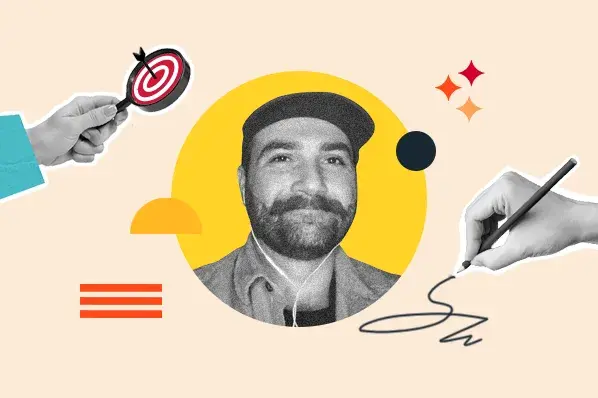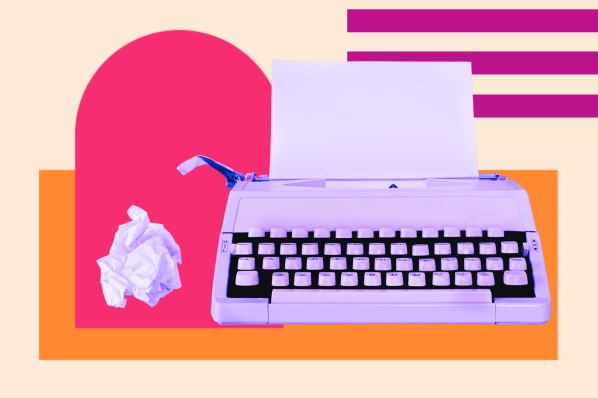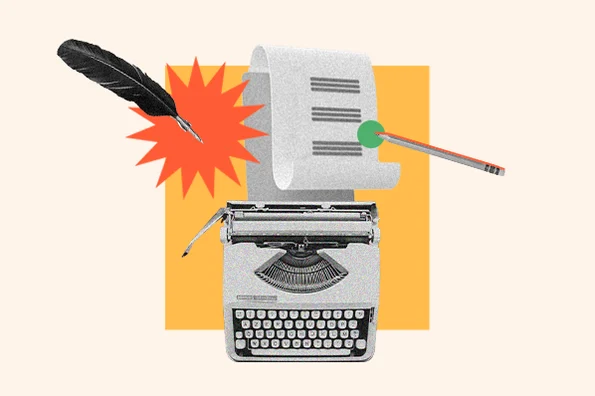
Both terms are useful and give customers important information they'll need during their buyer's journey, such as design, price, and real-world relevance. Ultimately, the benefits of having a product or service are what make consumers purchase, which means it is often best to highlight benefits over features when writing marketing copy. This paints a picture of what life will look like after the customer purchases the product or service. If you do decide to highlight features, you'll want to make sure consumers understand how they'll benefit from those features.
Take this ad from Qordoba, an IT company that utilizes AI to help organizations manage communication.

The company's ad caught my eye by communicating the benefits reading the report will have when it comes to customer-facing content, which does interest me.
'How are tech companies managing their voice, tone, & writing style guides across their various types of customer-facing content?'
After reading this caption, I knew exactly what I would gain from this product, and why it was worth my time.
Let's look at another example of features and benefits at work. This is a marketing email I got this morning from Marriott hotels:

This ad starts with the benefits of becoming a Marriott member — 'yes to vacation views' — while the rest of it explains the features of the program, including 'no annual fees' and '3X points per $1 spent at more than 7,000 Marriott locations.
Emphasizing that Marriott members enjoy free perks, then expanding on how this is done (by earning rewards points), is a really effective way to explain the benefits and features of the rewards membership.
This is relatively straightforward — but what if you have multiple products being sold at once?
If you're working with more than one campaign, the answer to whether you should use features versus benefits " can change depending on the product or service being marketed.
How to Tell When it’s Best to Use Features or Benefits
If you're unsure whether you should list features or benefits for a given product, consider this — features are an optimal choice in a saturated market. For instance, a small business making a meal-delivery kit would have some competition (such as HelloFresh or Home Chef), meaning they would have to communicate their service's competitive advantage by naming one-of-a-kind features. This would include price, dietary restrictions, menu configuration, etc.
Benefits, on the other hand, are the way to go if your brand exists within a niche market or a "drier" topic. You'll want to answer the following questions with your benefits:
- How does it work?
- How does it make a consumer's life easier?
To resonate well with an audience who perhaps haven't heard of your product or service before, try to include benefits in your demos, ebooks, and other marketing content.
Now that we're more clear on features vs. benefits, let's explore some examples to see both in-action.
Examples of Features and Benefits
For the visual learners like myself, below are some real-world examples of how to work features or benefits into ads, product pages, email, or any other marketing materials:
1. Calm (features)

Why This Is a Feature: Calm used singer Lindsey Stirling’s material as an exclusive offer only available to app users. It’s a unique attribute the audience can’t get anywhere else.
This email about an exclusive deal made me excited, which is another way highlighting features in your marketing material can be beneficial — to build excitement. Here's how sleep meditation company Calm did it:
Framing singer/songwriter Lindsey Stirling 's work as an exclusive feature improves customer relationships and makes them feel special. Opening this email made me think about how glad I am to be an email subscriber (especially since I grew up watching Stirling on YouTube) because of cool offers like this.
If you're running a promotion or want to improve customer relationships, consider sending them an offer that reminds customers of your product or service's unique features.
2. HubSpot Academy (benefits)

Why these are benefits: HubSpot Academy gives customers the opportunity to invest in themselves by learning new skills and getting certifications they can display on LinkedIn – all things that will help them grow their business and individual careers.
In this product page for HubSpot Academy's social media course, three benefits are listed at the bottom, so prospects can see how completing this course will be worth their time.
Benefits don't always have to be short phrases – in fact, on product pages, more is often better. On web pages, it's critical you give your customers the helpful information they need — including cost, structure, time required to complete, and a description on how your products or services' benefits outweigh the benefits of competitors'.
3. OrganiGrowHairCo (benefits)

Why these are benefits: This ad effectively communicates the reasons why OrganiGro’s co-wash product is better than typical conditioners. It alleviates dandruff, decreases breakage, and cleanses – all things that will aid a buyer's hair health.
If you’re team natural hair, you’ve more than likely stumbled upon the heaps of content stressing the benefits of co-washing (using conditioner only) as a way to avoid overwashing your hair with regular shampoo. Since shampoo often strips the hair as it cleanses, co-washing is seen as a method to replenish moisture between washes.
In the Instagram ad above, OrganiGrow clearly makes the case for why its co-wash formula is superior to the competition as it’s designed to cleanse while moisturizing, aiding the customer’s overall hair health.
4. Arcadia (benefits)

Why this is a benefit: The ad draws the audience in immediately with the potential to save on their utility bill. Who doesn’t want to save money? The promotion also throws in a Google Home mini, which further incentivizes the customer to buy.
Can you spot the benefits energy company Arcadia used in this promoted tweet?
If you chose the entire tweet, you're right!
Almost every word helps describe to the reader why they should open the linked website. As a consumer, I would think, "Well, what is the easiest way to save on my energy bill at no cost? That thing is sky high!"
Words that help the consumer are going to resonate with those who are just mindlessly scrolling and not necessarily looking to buy anything. To build interest in their promotion, Arcadia's use of benefits to entice prospective customers was a good choice on Twitter.
Impress a scroller by using benefits in marketing messages. You have just a few seconds to leave a mark.
5. Airtable (features)

Why this is a feature: By playing up its fun colors and project management attributes, Airtable entices viewers to switch from boring spreadsheets. All of its sleek features are on full display in this Facebook ad. How is it better than traditional spreadsheets? It’s ‘flexible, beautiful, and fun.’
Beautiful, descriptive features in this Facebook ad told me exactly what Airtable is and what their software does, despite having no previous knowledge. In less than thirty words, I know that Airtable must be a product or service that makes dull spreadsheets a thing of the past — for free.
6. KeVita (benefits)
Why this is a benefit: This scenario-based ad positions KeVita kombucha as the perfect natural energy drink, giving customers a boost for whatever activity they partake in, no matter the location.
Kombucha is a fermented tea drink with probiotics, which aid in helping digestion and improving energy levels. So, when marketing their kombucha on Instagram, the KeVita brand wanted to show that kombucha isn't just a summer drink, contrary to popular belief.
Aesthetically pleasing, benefit-enforcing GIFs like this make visual platforms like Instagram a perfect canvas for an ad that displays benefits.
Animation often stops scrollers — especially animation paired with bright pink text. The backdrop, a ski lift covered in fresh snow, ("powder" to skiers), shows the accessibility of the drink, while the caption alludes to kombucha-fueled energy to get through a long ski trip.
Two benefits that instantly stuck out to me about this post are accessibility and energy. On snowy mountains, those two functions are going to be essential when thinking about snacks. Consider a scenario-based ad if your product is like KeVita, commonly perceived as a summer drink.
7. Dyson (benefits)
Why this is a benefit: This animated ad focuses on how Dyson’s humidifier removes pollutants from your home to improve air quality. It’s an all-in-one solution for customers combining the perks of a humidifier, air purifier, and fan.
Our homes are full of contaminants, or at least that is what this ad will have you believe. With this ad for its air purification system, Dyson really drives home the “why” for customers using some pretty convincing animation. Microscopic pollutants like dust, pet dander, and others are in our home, wreaking havoc on sensitive respiratory systems. This device will remove them, enabling customers to breathe better. It addresses the problem and clearly explains how their product is a solution to that problem.
Applying Benefits and Features to Your Marketing Strategy
From phones to shampoo, the features or benefits marketing method can be applied to almost anything. When creating copy:
- Determine what you want to say, and which messaging method will be best for that.
- Ask "Does this ad convey features or benefits?"
It's important to know the distinction between the two so the audience receives clear messaging that explains why they should choose your product or service over the rest.
This article was originally published February 27, 2020 and has been updated for comprehensiveness.
Copywriting













